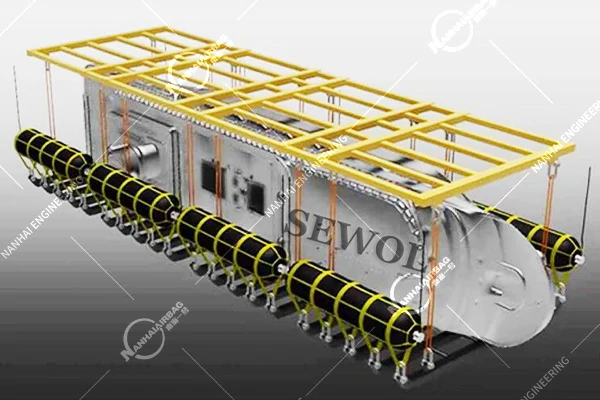Крылья из морской подушки: Полное руководство
09/18/2025Недорогая транспортировка кессона с помощью морских подушек безопасности
09/22/2025Как работают подушки безопасности для морских спасателей?
Морские спасательные подушки безопасности играют важную роль в судоходстве. Эти надувные мешки быстро и безопасно поднимают и возвращают на плаву севшие на мель или затонувшие суда. Их конструкция проста, но эффект от них мощный. В этом руководстве мы объясним, что такое морские спасательные подушки безопасности, как они работают и почему они полезны во многих морских проектах.
Что такое морские спасательные подушки безопасности?
Морские спасательные подушки безопасности - это большие резиновые мешки цилиндрической формы, наполненные сжатым воздухом. Надуваясь, они создают сильную плавучесть, которая помогает поднимать или перемещать тяжелые суда. Судостроительные верфи и спасательные команды Предпочтение им отдается потому, что они гибкие, портативные и более экономичные, чем краны или плавучие доки.
Они бывают разных размеров. Большие подушки вмещают больше воздуха и обеспечивают большую подъемную силу. Благодаря их гибкости экипаж может разместить их под или рядом с корпусом судна, чтобы добавить плавучести там, где это больше всего необходимо.

Как работают подушки безопасности для морских спасателей?
Принцип работы подушек безопасности для морских спасателей заключается в плавучести. Когда рабочие наполняют подушку сжатым воздухом под водой, она выталкивает окружающую воду. В результате подушка создает силу, достаточную для подъема корпуса судна.
Во время операции команда устанавливает несколько подушек безопасности в запланированные места. Они медленно надувают каждую подушку, контролируя давление. Регулируя одновременно несколько подушек безопасности, команда может безопасно и сбалансированно поднимать или опускать судно.
Этот процесс может показаться простым, однако он требует тщательного планирования. Инженеры рассчитывают, сколько плавучести необходимо, сколько подушек безопасности нужно использовать и где именно их разместить. Поскольку сила воздействия очень велика, на каждом этапе очень важна проверка безопасности.
Поэтапная операция по спасению
Операция по спасению обычно проходит следующим образом:
- Исследование и планирование - Команда осматривает судно и рассчитывает необходимую общую плавучесть.
- Размещение подушек безопасности - Водолазы или рабочие размещают подушки безопасности под корпусом судна или вокруг него.
- Обеспечение безопасности установки - Экипажи привязывают веревки или ремни, чтобы удержать подушки безопасности от сползания.
- Инфляция - Рабочие медленно наполняют подушки безопасности сжатым воздухом и проверяют давление.
- Подъем и стабилизация - Судно поднимается, когда раскрываются подушки безопасности. Команда удерживает его в вертикальном положении.
- Буксировка или эвакуация - Оказавшись на плаву, корабль переходит в безопасный док для ремонта.
Этот метод экономит время по сравнению с кранами и снижает затраты по сравнению с большими спасательными баржами.
Другие области применения подушек безопасности для морских спасательных работ
Морские спасательные подушки безопасности служат более чем одной цели. Помимо подъема затонувших судов, они поддерживают множество других проектов:
- Спуск и посадка кораблей на воду - Верфи используют воздушные подушки для спуска новых судов на воду или их посадки на мель для технического обслуживания.
- Подъем тяжелых грузов на суше - Рабочие перемещают большие трубы или механизмы с помощью воздушных подушек.
- Экстренная поддержка - Команды спасателей придают плавучесть поврежденным кораблям, чтобы предотвратить их затопление.
- Подводное строительство - Инженеры используют воздушные подушки для позиционирования подводных конструкций, таких как кессоны.
Эти примеры показывают, что морские спасательные подушки безопасности являются универсальным инструментом как для морских, так и для сухопутных проектов.
Дизайн и основные характеристики
От того, насколько хорошо работает подушка безопасности, зависит несколько конструктивных особенностей. Например:
- Диаметр и длина - Большие подушки безопасности обеспечивают большую плавучесть.
- Рабочее давление - Безопасное давление накачки контролирует подъемную силу.
- Прочность материала - Многослойная синтетическая резина обеспечивает долговечность и устойчивость.
- Коэффициент безопасности - Запас, встроенный в конструкцию, предотвращает несчастные случаи при подъеме.
Поэтому покупатели всегда должны подбирать размер и прочность подушки безопасности в соответствии с весом и состоянием судна.
Риски и меры безопасности
Несмотря на эффективность подушек безопасности, они требуют правильного обращения. К числу распространенных рисков относятся избыточное давление, скольжение или неравномерный подъем, повреждающий корпус. Для управления этими рисками операторы:
- Используйте несколько подушек безопасности, чтобы разделить нагрузку.
- Накачивайте их медленно, проверяя давление по манометру.
- Закрепите установку с помощью веревок или ремней.
- Подготовьте планы действий на случай, если одна сумка выйдет из строя.
Соблюдая эти меры предосторожности, бригады уменьшают опасность и повышают вероятность успеха.
Руководство по покупке
Выбор правильной подушки безопасности имеет большое значение. Покупатель должен обратить внимание на:
- Опыт и стандарты качества производителя.
- Протоколы испытаний и качество материалов.
- Доступны различные размеры.
- Послепродажное обслуживание и поддержка.
Кроме того, сотрудничество с надежным поставщиком обеспечивает более высокую производительность и безопасность работы.
Пример из практики
Например, однажды грузовое судно село на мель на мелководном побережье. Вместо того чтобы нанимать тяжелые краны, спасатели использовали морские спасательные подушки безопасности. Они поместили несколько мешков под корпус, постепенно надували их и постепенно поднимали судно. В результате судно всплыло в течение нескольких часов, и команда отбуксировала его в ремонтный док. Этот случай показывает, как подушки безопасности экономят и время, и деньги.
ЧАСТО ЗАДАВАЕМЫЕ ВОПРОСЫ
Вопрос 1: Какого размера суда могут поднимать морские спасательные подушки?
В зависимости от количества и размера подушек безопасности они могут поднимать любые суда - от небольших лодок до судов весом в тысячи тонн.
Q2: Безопасно ли использовать подушки безопасности в неспокойном море?
Экипажи обычно работают в спокойных водах. Бурное море повышает риск, поэтому команды по возможности избегают его.
Вопрос 3: Как долго служат морские спасательные подушки безопасности?
При регулярном осмотре и хорошем уходе подушки безопасности могут работать долгие годы.
Q4: Могут ли подушки безопасности повредить корпус корабля?
Нет, если экипаж использует подкладки или доски для защиты и тщательно контролирует давление, корпус остается в безопасности.
Q5: Можно ли использовать одни и те же подушки безопасности для запуска и спасения?
Да, многие верфи используют один и тот же тип подушек безопасности как для спуска на воду, так и для спасательных операций.
Заключение
Морские спасательные подушки безопасности создают плавучесть, которая позволяет поднимать тяжелые суда безопасным и эффективным способом. Экипажи по всему миру выбирают их, потому что они гибкие, доступные и простые в использовании. Кроме того, эти подушки безопасности помогают в реализации многих проектов, таких как спуск судов на воду, подводное строительство и подъем тяжелых грузов. При правильном планировании и соблюдении мер безопасности морские спасательные подушки безопасности остаются одним из самых практичных инструментов для современных морских операций.
